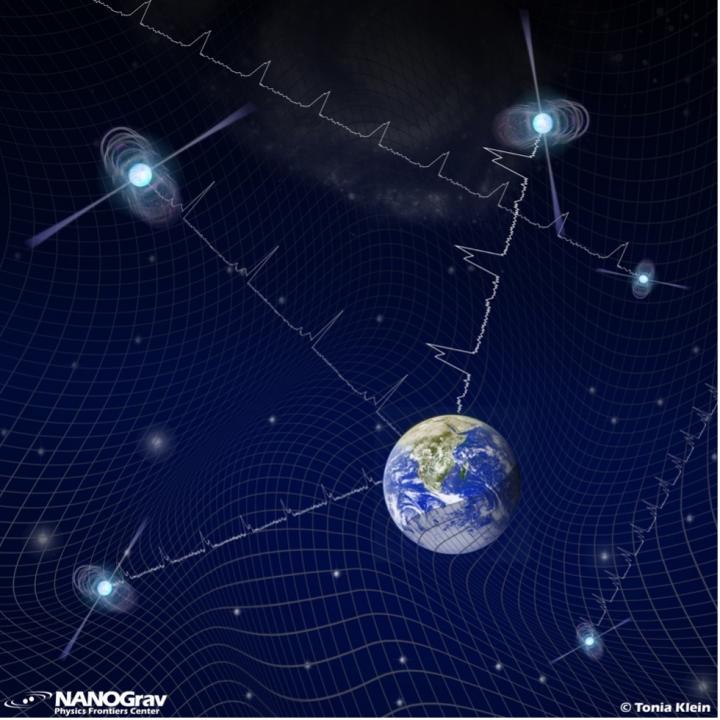CORVALLIS, Ore. – Oregon State University is the lead institution for a $17 million National Science Foundation center devoted to pushing the boundaries of physics knowledge by studying the universe through low-frequency gravitational waves, ripples in the fabric of time-space.
Funded by the NSF as a Physics Frontiers Center, the North American Nanohertz Observatory for Gravitational Waves, or NANOGrav, research group at OSU operates under the direction of Xavier Siemens, professor of physics in the OSU College of Science.
Siemens, who joined the Oregon State faculty in 2019, previously directed the NANOGrav Physics Frontier Center at the University of Wisconsin-Milwaukee, where it launched in 2015 with a $14.5 million award from the NSF.
The new five-year grant is a renewal co-directed by Siemens and Maura McLaughlin, an astronomer at West Virginia University. It will help fund a collaboration of roughly 200 astrophysics researchers at 18 universities, including OSU’s Davide Lazzati and approximately 20 graduate and undergraduate students at Oregon State. OSU will receive about $600,000 annually, Siemens said.
Gravitational waves were first directly observed, by the Laser Interferometer Gravitational-Wave Observatory, in September 2015, a milestone event in physics and astronomy that confirmed one of the main predictions of Albert Einstein’s 1915 general theory of relativity.
Researchers detected those gravitational waves, produced by the collision of two black holes, using the twin LIGO interferometers in Livingston, Louisiana, and Hanford, Washington. Gravitational waves detected by LIGO, created by those types of “black hole binaries,” have frequencies of about 100 hertz, or 100 cycles per second, Siemens said. LIGO is an NSF-funded international collaboration.
“We’re searching for gravitational waves with frequencies 11 orders of magnitude below those LIGO is detecting,” he said. “We use, instead of lasers and mirrors at the end of vacuum tubes, radio pulsars and radio telescopes. We can use those pulsars as clocks spread out through the sky, and we can see how the ticking of the clocks changes from gravitational waves passing through our galaxy.”
Pulsars are rapidly spinning remains of massive stars that exploded as supernovas, and they send out pulses of radio waves with extreme regularity; a group of them is known as a pulsar timing array, or PTA.
NANOGrav will search for gravitational wave signals with the Green Bank Telescope in West Virginia, the Very Large Array in New Mexico and the Canadian Hydrogen Intensity Mapping Experiment in Canada.
Siemens explains that using a PTA to detect a “chorus” of gravitational wave signals from multiple super-massive black hole mergers – described as a stochastic background of gravitational waves – holds more promise for understanding the universe than detecting a single wave from a single black hole binary collision.
“Each signal is like a note, and we’re not just after one of these notes – we want to hear the whole choir,” he said. “We want to hear the collective chorus of all of the super-massive black hole binaries that are merging in the universe.”
Super-massive black holes are the biggest type of black holes, millions to billions of times the mass of the sun, and they are in the centers of galaxies.
“We may already have seen the first hints of a gravitational-wave signal,” Siemens said. “This center will ensure that researchers have the resources necessary to explore one of the most exciting frontiers in all of physics and astronomy.”
Oregon State is one of 11 institutions to host an NSF Physics Frontiers Center and one of three from the Pacific 12 Conference; the other two Pac-12 schools are the University of California, Berkeley, and the University of Colorado. Rounding out the list of physics frontiers sites are the University of Rochester; Princeton University; the University of Illinois; Rice University; Massachusetts Institute of Technology; Caltech; Michigan State; and the University of Maryland.
The other centers’ research areas range from theoretical biological physics and the physics of living cells to quantum information and nuclear astrophysics.
###
Media Contact
Xavier Siemens
[email protected]
Original Source
https:/





